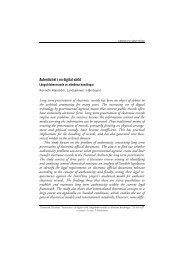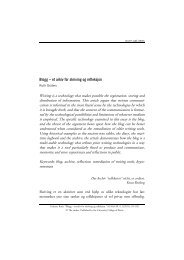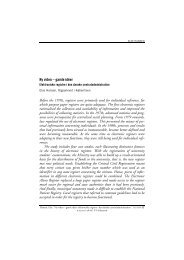The Challenge of Managing Affordances in Computer Game Play
The Challenge of Managing Affordances in Computer Game Play
The Challenge of Managing Affordances in Computer Game Play
Create successful ePaper yourself
Turn your PDF publications into a flip-book with our unique Google optimized e-Paper software.
HUMAN IT REFEREED SECTION<br />
namely direct perception and recognition. Accord<strong>in</strong>g to this view, direct<br />
perception provides us with <strong>in</strong>formation for locomotion and orientation<br />
<strong>in</strong> space, whereas recognition provides us with <strong>in</strong>formation about the identification<br />
and classification <strong>of</strong> objects and events, and recognition is<br />
more effective if we are able to accumulate <strong>in</strong>formation about the features<br />
<strong>of</strong> an object or arrangement. Neisser’s idea comes close to Gibsons’<br />
theory <strong>of</strong> perceptual learn<strong>in</strong>g (1955), which is described as “respond<strong>in</strong>g to<br />
variables <strong>of</strong> physical stimulation not previously responded to”. Perceptual<br />
learn<strong>in</strong>g, <strong>in</strong> other words, is about learn<strong>in</strong>g differentiat<strong>in</strong>g qualities <strong>of</strong><br />
stimuli <strong>in</strong> the environment, such as a person’s ability to identify different<br />
types <strong>of</strong> sherry or red w<strong>in</strong>e. <strong>The</strong>y po<strong>in</strong>t out, however, that their theory <strong>of</strong><br />
perceptual learn<strong>in</strong>g does not account for misperception, as it does not tell<br />
us anyth<strong>in</strong>g about how imag<strong>in</strong>ation, fantasy, or wishful th<strong>in</strong>k<strong>in</strong>g might<br />
affect our perception <strong>of</strong> objects and events <strong>in</strong> the environment, aspects<br />
that are arguably <strong>in</strong>tegral parts <strong>of</strong> game play activities.<br />
Another complementary explanation for how players perceive possible<br />
actions <strong>in</strong> a game might be found <strong>in</strong> the area <strong>of</strong> embodied cognition. We<br />
have already mentioned that as we attach some object to the body, we extend<br />
ourselves and our action capabilities <strong>in</strong> an act <strong>of</strong> embody<strong>in</strong>g. Recent<br />
research on embodied cognition also suggests that the recognition <strong>of</strong> objects<br />
and their use is related to bodily experience, which does not simply<br />
specify perception and action aspects <strong>of</strong> an object but – <strong>in</strong> the Gibsonian<br />
sense – the mutual relationship between agent and environment (e.g.<br />
Grafton et al. 1997; Johnson-Frey 2004). For <strong>in</strong>stance, the recognition<br />
and nam<strong>in</strong>g <strong>of</strong> objects appears to be related to sensorimotor experiences,<br />
i.e., we simulate previously performed actions. This would mean that:<br />
She perceives the door as a door and as “open-able”, because she associates<br />
the picture <strong>of</strong> it with previous bodily experiences <strong>of</strong> open<strong>in</strong>g and pass<strong>in</strong>g<br />
through doors.<br />
A Herculean Task?<br />
Undoubtedly, op<strong>in</strong>ions on what constitutes an affordance are mixed, result<strong>in</strong>g<br />
<strong>in</strong> confusion and misunderstand<strong>in</strong>gs among researchers and designers.<br />
So far, when try<strong>in</strong>g to expla<strong>in</strong> the relevance <strong>of</strong> affordances <strong>in</strong><br />
people’s <strong>in</strong>teraction with virtual worlds, most researchers focus almost<br />
102









